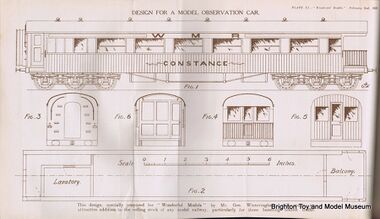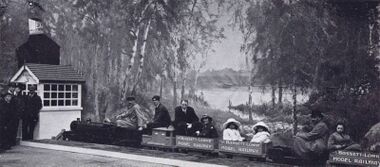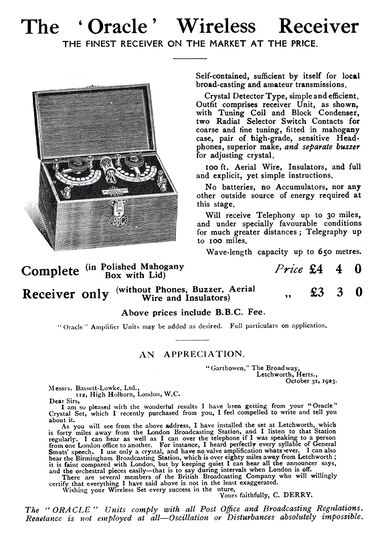Category:Winteringham Ltd
"Design for a Model Observation Car", George Winteringham, "Wonderful Models" 1928 [image info]
James Mackenzie at the controls of a fifteen-inch-gauge steam locomotive [image info]
Possibly James Mackenzie at the controls once again? Olympia, 1913. W.J. Bassett-Lowke is sitting in one of the middle carriages [image info]
Oracle Wireless Receiver, Winteringham Ltd, 1924. The Winteringham "WN-inside-cog" logo is just visible. [image info]
Winteringham Ltd. were a toy and model manufacturing company in Northampton that were very closely associated with Bassett-Lowke, to the extent that the company is sometimes assumed to have been a subsidiary of B-L.
George Winteringham
George Winteringham was a draughtman and model engineer. Dissatisfied with tinplate track, Winteringham invested in the equipment to make proper drawn metal rails and cast "chairs" for his own use, and then advertised the excess material in Model Engineer magazine, where W.J. Bassett-Lowke saw the advert and started stocking the track (the term then in use for railway track being "permanent way".
W.J. used his persuasive powers to get George Winteringham to move to Northampton, and set up Winteringham Ltd. in 1908. George Winteringham was the Managing Director, in charge of design and special projects, and Scots engineer James Mackenzie was the Works Manager in charge of day-to-day production issues, with the new company having a factory building in St. Andrews Street.
Winteringham became Bassett-Lowke Ltd.'s main general-purpose production site in Northampton, and although it was called upon to produce larger and more specialised pieces from time to time, its main function was to be B-L's "factory", producing model railway track and other "stock" items that wouldn't be appropriate for B-L's more specialised "artist's" model studios such as Twining Models.
Post-WW1
After the First World War, Winteringham's focus on mass-producable products rather than on individually-engineered pieces sharpened under Mackenzie's supervision, with the company demanding the right to make products that had longer production runs than B-L were necessarily used to, and insisting on the opportunity to make money by making and selling products that might not be designed exclusively for B-L, and selling them directly to the trade. If Winteringham's was going to be a proper factory, it had to be free to act like a normal manufacturing business. This was even more important since anti-German sentiment had effectively broken the stranglehold that B-L's suppliers Märklin and Bing had had on metal toy production, and this had encouraged Frank Hornby's Meccano Ltd. to finally get into the business of making gauge 0 model railways.
The Meccano Ltd. threat
Meccano Ltd had never been a "bespoke products" company, and were unencumbered by any existing "legacy" model railway ranges - they only supplied pieces in a single gauge, gauge 0, and their large factory started churning out model train sets in gauge 0 that, while initially very "toyish", continued to improve in accuracy. While Meccano Ltd. weren't competing directly with Bassett-Lowke (yet!) they were changing the landscape of the model railway business. Faced with the threat of Meccano Limited and perhaps other future competitors, making Winteringham a more "businesslike" business was essential.
Winteringham's also inherited George Carette's machine tools and plans, and wagons that had previously been made in Germany by Carette for Bassett-Lowke started to be made at Winteringham's, which also had to "pick up the slack" and start manufacturing locomotives that could replace the ranges previously made for B-L by Märklin and Bing.
Winteringham's move away from "model engineering" products continued, with James Mackenzie (who'd become Managing Director) now stepping down in favour of his assistant, Robert Bindon Blood, with Blood's first projects including Bassett-Lowke's well-received gauge 0 Flying Scotsman and Royal Scot models, launched in 1929.
Emerging links with Trix Limited
When Stefan Bing's new manufacturing company was persuaded by B-L to start making half-size 00-gauge model railways, and Stefan Bing and Siegfried Kahn had to move to the UK to escape the rise of Nazi rule in Germany, Trix Limited's new UK production was taken in by Winteringham. This did create certain tensions, with Trix wanting to sell the resulting train sets directly to major outlets such as Hamleys, but with B-L regarding the Trix sets as essentially "theirs", to the extent of removing the Trix name from promotional materials wherever possible. This may have led to a certain amount of confusion in the minds of Winteringham employees as to who they were actually working for - Winteringham, Trix or B-L - and Stefan Bing is said to have taken to prowling the Winteringham plant to make sure that staff producing his contracted products weren't being diverted to B-L work.
This was eventually resolved to a great extent by Trix taking control of Winteringham under the new name Precision Models.
Early links with Mettoy
A side-note to Winteringham's post-WW1 reorganisation is that as well as Stefan Bing, Winteringham also played host to another couple of refugees from Nazi Germany, Philip Ullmann and Arthur Katz, who had previously worked at Tipp & Co. in Germany.
Ulmann and Katz had experience of simple metal toy production, and with the help of some good contacts, they established Mettoy in the UK, with manufacturing space initially being found for them in the Winteringham plant.
Mettoy eventually found their feet in the production of diecast model cars, in a new factory, under the 'Corginame. It's perhaps a measure of how strongly Bassett-Lowke were still fixated on model engineering and unable to imagine producing "mere toys" let alone toys of cars (which W.J. apparently disliked), that not only did B-L totally fail to capitalise on this emerging market, but at one point they had a future market leader actually operating out of the basement at Winteringham without apparently recognising the opportunities.
Logo and branding
Since Winteringham's output seems to have mostly gone through Bassett-Lowke, there doesn't seem to be much promotional material relating to the company, and original printed information about Winteringham is so sparse that some sources actually get the name wrong (and spell it "Wintringham", or even "Witteringham"). This almost deliberate-looking policy of obscurity wasn't helped by Winteringham's habit of avoiding using their own name even when they DID brand products, adopting instead a "W-over-N" symbol, which looked noticeably similar to the Bing Werke B-over-W symbol, and which presumably stood for "Winteringham, Northampton".
While it's easy to interpret the WN trademark as a simple ripoff of Bing's symbol, and an attempt to confuse buyers, another possible interpretation might be - depending on the exact date at which Winteringham started using the symbol - that the WN was intended as a deliberate reference to Winteringham being (arguably) the successor to Bing (which failed in the inter-war years). When Bing Werke went bust, Stefan Bing and some Bing employees started a new company, and then decamped to Britain to Trix Limited, its UK offshoot, where they designed and made 00-gauge model trains that were the spiritual descendants of the earlier Bing Tabletop Railway sets.
These new Trix train sets were made at ... Winteringham.
Precision Models
Some time around 1940, Trix Ltd effectively took over the Winteringham facility, creating Precision Models (at Stimpson Avenue, Northampton).
We'll try to add more information about this as we find it.
Tensions
One of the difficulties facing an outsider trying to pin down the identity and character of Winteringham Ltd. is that it seems as if the company may itself have had trouble understanding what it's purpose and goals were.
The renaming as "Precision Models" at least provided some sort of mission statement as to what the company did at least some of the time, but there still seem to have been some deep and fundamental conflicts within the company.
Was PM supposed to be a general-purpose manufacturing company that manufactured whatever its clients wanted, or was it supposed to stick to serious, specialist engineering? Was it a purely manufacturing company creating products for Bassett-Lowke and Trix, or was it supposed to be developing its own brand and creating its own products (like the "Oracle" crystal radio sets). When resources were limited, what was it supposed to do when Trix (its owner) and Bassett-Lowke (it's historical near-founder) were competing for the same resources? To what extent was it supposed to prioritise its historical ties and obligations to B-L as opposed to its legal and financial obligations to Trix Ltd.?
Similarly, when it came to developing the Trix line, was it supposed to target new customers by updating the rather old and clunkily-engineered Trix wheels to be more like the modern and better-looking Dublo and Triang ranges, even though this meant that old stock might then not run on the new points? Or was it supposed to stay with the "legacy" designs to placate existing customers, but risk finding itself selling to an ever-dwindling customer-base?
Addresses
So far we've managed to dig up two addresses for the company, St Andrews Street, Northampton, and then Stimpson Avenue, Northampton. Mettoy's founders (company registered in (1932) moved to Northampton when they came to the UK, and started working out of Winteringham's "St Andrews Street" address some time around 1933/34.
Patents
The company also registered five patents, which give an indication of its focus:
- Improvements in and relating to clockwork mechanism for mechanical models and toys, JAMES MACKENZIE / WINTERINGHAM LTD, GB311573 (A), 1929-05-16 / 1928-06-07
- Improvements in and relating to clockwork mechanism for mechanical models and toys, JAMES MACKENZIE / WINTERINGHAM LTD, GB320896 (A), 1929-10-24 / 1928-07-24
- Improved construction of coupling for toy trucks and other vehicles, JAMES MACKENZIE / WINTERINGHAM LTD, GB425904 (A), 1935-03-20 / 1933-09-20
- Improvements in or connected with electric toy locomotives, WINTERINGHAM LTD / JAMES MACKENZIE GB430754 (A) 1935-06-21 / 1933-12-21
- Improvements connected with toy railways, WINTERINGHAM LTD / JAMES MACKENZIE, GB430755 (A), 1935-06-21, Priority date: 1933-12-21
External links
- possibly the same Robert Bindon Blood, (thepeerage.com)
- Northampton Society of Model Engineers Ltd. (nsme.co.uk)
- The Gazette, 31 August 1971, apparent liquidation notice for Precision Models, 107 Stimpson Avenue, Northampton (thegazette.co.uk)
Subcategories
This category has the following 3 subcategories, out of 3 total.
B
M
T
Media in category ‘Winteringham Ltd’
The following 3 files are in this category, out of 3 total.
- Design for a Model Observation Car, George Winteringham (WM 1928).jpg 1,200 × 691; 331 KB
- James Mackenzie and 15-inch-gauge steam locomotive.jpg 2,000 × 1,061; 448 KB
- Oracle Wireless Receiver, Winteringham Ltd (BL-B 1924-10).jpg 1,513 × 2,200; 542 KB









